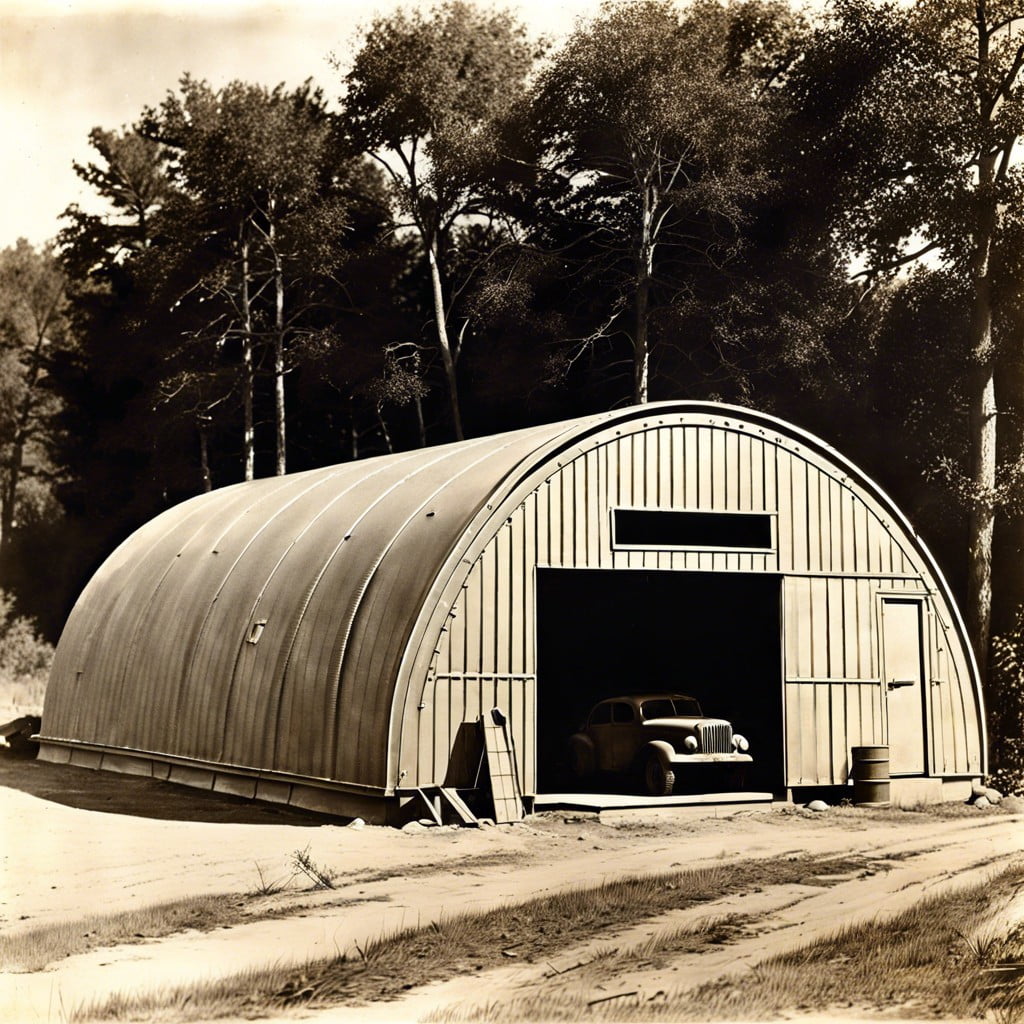Learn about the advantages, construction, and uses of steel Quonset huts in this detailed guide.
Key takeaways:
- Quonset huts have a rich history and are known for their durability.
- They are made from corrugated galvanized steel and are easy to customize.
- Quonset huts are cost-effective, versatile, and maximize interior space.
- They are easy to install and require minimal maintenance.
- Quonset huts are affordable and eco-friendly, made from recycled steel.
History of Steel Quonset Huts

Developed during World War II for the U.S. Navy as lightweight, easily transportable buildings, these structures provided a quick solution for versatile housing and storage needs. Named after the site of their first installation at the Davisville Naval Construction Battalion Center in Quonset Point, Rhode Island, these huts were crafted to offer strength, durability, and easy assembly. Initially serving as barracks, offices, and hospitals in war zones, they rapidly gained popularity.
Post-war surplus saw these huts repurposed by civilians for agricultural, industrial, and residential projects. Their corrugated steel design, forming a semi-circular arch, allows them to withstand harsh weather conditions while maximizing internal space. This adaptability and resilience have preserved their popularity up to the present day. Their historical significance and practicality combine to make them a favored choice in contemporary metal building applications.
Design and Material Specifications
Steel Quonset huts are characterized by their semi-cylindrical shape, which is both practical and space-efficient. Crafted from corrugated galvanized steel, these structures boast exceptional durability and resistance to harsh weather. The arch design not only facilitates easy construction but also provides natural strength, eliminating the need for interior columns or supports.
The panels used in a Quonset hut easily join together with overlapping edges, ensuring a tight seal against the elements. This construction allows for extensive customization in size and accessories; doors, windows, and ventilation systems can all be incorporated according to specific requirements.
This combination of simple construction and strong materials makes the Quonset hut an enduring choice for uses ranging from agricultural storage to automotive workshops. Its lightweight nature also allows for relocation if necessary, providing flexibility in usage and site placement.
Benefits and Applications of Steel Quonset Huts
Steel Quonset huts offer a versatile solution for various needs, ranging from residential to industrial uses. Their arch-shape design, made primarily from steel, contributes to extreme durability and strength, allowing these structures to resist harsh weather, including heavy snow and high winds.
One of the primary advantages of these huts is their cost-effectiveness. They are less expensive than traditional buildings and can be constructed in less time. The simplicity of their design also minimizes labor costs and speeds up the assembly process.
Moreover, these huts provide a clear span of space, lacking internal columns, which maximizes usable interior space. This feature makes them ideal for warehouses, agricultural storage, and workshops where large equipment or unobstructed movement is necessary.
Their adaptability also shines, as these buildings can be equipped with insulation, windows, and doors to serve as offices, garages, or even homes. The exterior can be customized with various finishes, aligning with aesthetic preferences or integration into existing structures.
Given their steel construction, these huts are fire-resistant and impervious to pests like termites, contributing to their longevity and sustainability. This makes them a practical choice for those committed to safety and eco-friendly considerations.
Installation and Maintenance
Setting up a steel Quonset hut can be surprisingly straightforward but requires careful planning. First, choose a flat and accessible site to ensure a smooth assembly process. Most kits come with detailed instructions, making it feasible for those with basic DIY skills to undertake the project. However, it’s often wise to enlist a professional for tasks involving heavy lifting or complex configurations.
Once installed, maintenance is minimal. These structures are made from corrosion-resistant steel, helping them withstand harsh weather and pests. Periodically check for scratches in the paint or any signs of rust. Regular cleaning, using mild soap and water, will keep the exterior looking fresh.
A well-installed and maintained Quonset hut can provide reliable service for decades, making them a practical choice for various storage or operational needs.
Pricing and Eco-Friendly Attributes
Steel Quonset huts offer a cost-effective solution compared to traditional building materials. Generally, prices range based on size, customization, and supplier, but typically a basic kit can start from a few thousand dollars, making it accessible for many budgets.
Regarding environmental impacts, these structures shine with several green qualities. They are predominantly made from recycled steel, which contributes significantly to resource conservation. Additionally, their curved shape enhances energy efficiency by effectively circulating air, thus reducing the need for extensive heating and cooling systems. This attribute not only lowers energy consumption but also decreases the carbon footprint associated with operational energy use.
Maintenance demands are modest, as steel is resistant to many of the factors that degrade other materials, such as pests, fire, and weather extremes. This durability translates to lesser replacements and repairs, bolstering their sustainable profile.
By combining affordability with eco-conscious features, these huts present a compelling choice for conscientious consumers aiming to balance cost with environmental responsibility.




